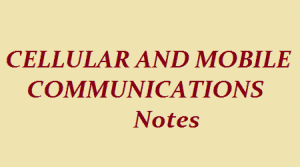Here you can download Cellular Mobile Communication Pdf Notes – CMC Pdf Notes with multiple file links to download. The Cellular Mobile Communication Notes Pdf (CMC Notes) book starts with the topics covering Limitations of conventional mobile telephone systems, Concept of frequency rettse, Measurement of real time Co-Channel interference, Near end far end interference, Cell Coverage for Signal and traffic Signal reflections in tlat and hilly terrain, Cell Site and Mobile Antennas Sum and difference patterns and their synthesis, Frequency Management and Channel Assignment Numbering and grouping, Handoffs and Dropped Calls Handoff initiation etc.

Cellular Mobile Communication Pdf – CMC Pdf
Cellular Mobile Communication Notes – CMC Notes Latest Material Links
Link – Complete Notes
Unit 1
Link – Unit 1 Notes
Unit 2
Link – Unit 2 Notes
Unit 3
Link – Unit 3 Notes
Unit 4
Link – Unit 4 Notes
Unit 5
Link – Unit 5 Notes
Unit 6
Link – Unit 6 Notes
Unit 7
Link – Unit 7 Notes
Unit 8
Link – Unit 8 Notes

Old Material Links
Download CMC – Notes here
Unit I : CMC Notes
Introduction To Cellular Mobile Radio Systems: Limitations of conventional mobile telephone systems. Basic Cellular Mobile System. First. second. third and fourth generation cellular wireless systems. Uniqueness of mobile radio environment-Long term fading. Factors influencing short term fading. Parameters of mobile multipath fading-Time dispersion parameters. Coherence bandwidth. Doppler spread and coherence time. Types of small scale fading.
Download CMC – Notes 1 here
Unit II : CMC Notes
Fundamentals Of Cellular Radio System Design: Concept of frequency rettse. Co-channel interference. Co-channel Interference reduction factor. Desired C/I from a normal case in a omni directional antenna system. system capacity. Trunking and grade of service. Improving coverage and capacity in cellular systems- Cell splitting. Sectoring. Mictocell zone concept.
Download CMC – Notes 2 here
Unit III : CMC Notes
Co-Channel Interference : Measurement of real time Co-Channel interference. Design of antenna system. Antenna parameters and their effects. Diversity techniques-Space diversity. Polarization diversity. Frequency diversity. Time diversity. .’
Download CMC – Notes 3 here
Cellular Mobile Communication Notes – CMC Notes
Unit-IV : CMC Notes
Non-Co-Channel Interference l Adjacent channel interference. Near end far end interference. Cross talk. I Effects on coverage and interference by power decrease. Antenna height decrease. Effects of cell site components. UHF TV interference.
Download CMC – Notes 4 here
Unit V : CMC Notes
Cell Coverage for Signal and traffic Signal reflections in tlat and hilly terrain. Effect of human made structures. Phase difference between direct and reflected paths. Constant standard deviation. Straight line path loss slope. General formula for mohile propagation over water and flat open area. Near and long distance propagation. Path loss from a point to point prediction model in different conditions. merits of Lee model .
Download CMC – Notes 5 here
Unit Vl : CMC Notes
Cell Site and Mobile Antennas Sum and difference patterns and their synthesis. Coverage-omni directional antennas. Interference reduction— directional antennas for interference reduction. Space diversity antennas. Umbrella pattern antennas. and Minimum separation of cell site antennas. mobile antennas.
Download CMC – Notes 6 here
Unit-VII : CMC Notes
Frequency Management and Channel Assignment Numbering and grouping. Setup access and Paging channels. Channel assignments to cell sites and mobile units. Channel sharing and Borrowing. Sectorization. Overlaid cells. Non fixed channel assignment.
Download CMC – Notes 7 here
Unit-VIII : CMC Notes
Handoffs and Dropped Calls Handoff initiation, Types of handoffs. Delaying ltandoff. Advantages of handoff. Potter difference handoffs. Forced handoff. Mobile assisted and soft hancloff. lntersystem handoff. Introduction to dropped call rates and their evaluation.
Download CMC – Notes 8 here
Cellular Mobile Communications (CMC) Notes Pdf – JNTUH | B.Tech Notes 2025


Are you looking for detailed Cellular Mobile Communications (CMC) notes for your B.Tech studies? You’ve come to the right place! Here, we provide Cellular Mobile Communications Notes Pdf that cover all the essential topics you need to excel in your course. These notes are tailored according to the JNTUH (Jawaharlal Nehru Technological University Hyderabad) syllabus and are perfect for exam preparation.
CMC Notes Pdf
The Cellular Mobile Communications Notes Pdf includes comprehensive material on topics such as frequency reuse, co-channel interference, cell site coverage, mobile antennas, frequency management, and handoff mechanisms. These notes are designed to give you a clear understanding of the key concepts in mobile communication.
Cellular Mobile Communications Pdf Lecture Notes – JNTUH
The CMC Pdf Notes are organized according to the JNTUH syllabus for B.Tech 2025. They are a valuable resource for students who want to learn and revise the fundamentals of mobile communications.
Cellular Mobile Communications Notes, PDF | CMC B.Tech (2025)
Below is your complete guide to Cellular Mobile Communications Notes with links to download the latest materials for each unit.
Description
The Cellular Mobile Communications (CMC) course covers the basic concepts of cellular mobile systems, including frequency reuse, interference, antenna systems, cell coverage, and handoff mechanisms. Understanding these topics is crucial for students aiming to work in the field of wireless communication.
Overview of CMC Notes Pdf
These CMC Notes Pdf are designed to provide in-depth knowledge of the subject, including practical examples and applications. You can download the notes for individual units or access the complete set for a holistic understanding.
The following topics are covered in the Cellular Mobile Communications handwritten Notes
- Introduction to Cellular Mobile Radio Systems
- Fundamentals of Cellular Radio System Design
- Co-Channel Interference
- Non-Co-Channel Interference
- Cell Coverage for Signal and Traffic
- Cell Site and Mobile Antennas
- Frequency Management and Channel Assignment
- Handoffs and Dropped Calls
Links to download CMC Notes Pdf
Download the Cellular Mobile Communications Notes Pdf from the links provided below for each unit.
- Latest Material Links:
- Unit 1: Introduction to Cellular Mobile Radio Systems
Download CMC Unit – 1 Notes - Unit 2: Fundamentals of Cellular Radio System Design
Download CMC Unit – 2 Notes - Unit 3: Co-Channel Interference
Download CMC Unit – 3 Notes - Unit 4: Non-Co-Channel Interference
Download CMC Unit – 4 Notes - Unit 5: Cell Coverage for Signal and Traffic
Download CMC Unit – 5 Notes - Unit 6: Cell Site and Mobile Antennas
Download CMC Unit – 6 Notes - Unit 7: Frequency Management and Channel Assignment
Download CMC Unit – 7 Notes - Unit 8: Handoffs and Dropped Calls
Download CMC Unit – 8 Notes
- Unit 1: Introduction to Cellular Mobile Radio Systems
- Complete Notes
Download Complete CMC Notes here
CMC Notes and Study Material PDF Free Download
These Cellular Mobile Communications Notes are available for free download and cover all the critical concepts needed to master the subject. Whether you are preparing for exams or working on a project, these notes will guide you through every step.
Topics Covered in CMC Notes Pdf
Here’s a summary of the major topics covered in the CMC Notes Pdf:
- Unit 1: Introduction to Cellular Mobile Radio Systems
- Limitations of conventional mobile telephone systems
- Cellular mobile system generations (1G to 4G)
- Fading, time dispersion parameters, and small-scale fading
- Unit 2: Fundamentals of Cellular Radio System Design
- Frequency reuse, co-channel interference, and trunking
- Coverage and capacity improvement techniques (cell splitting, sectoring, microcell zone concept)
- Unit 3: Co-Channel Interference
- Real-time co-channel interference measurement
- Antenna design and diversity techniques (space, polarization, frequency, and time diversity)
- Unit 4: Non-Co-Channel Interference
- Adjacent channel interference, near-end far-end interference, cross-talk
- Effects of power and antenna height on coverage and interference
- Unit 5: Cell Coverage for Signal and Traffic
- Signal reflections in flat and hilly terrain
- Path loss models for mobile propagation, including Lee model
- Near and long-distance propagation
- Unit 6: Cell Site and Mobile Antennas
- Omnidirectional and directional antennas, space diversity antennas
- Umbrella pattern antennas, minimum separation of cell site antennas
- Unit 7: Frequency Management and Channel Assignment
- Channel assignment techniques (fixed, dynamic, and non-fixed)
- Numbering, grouping, and sectorization
- Channel sharing and borrowing, overlaid cells
- Unit 8: Handoffs and Dropped Calls
- Handoff initiation, types of handoffs, forced handoff
- Mobile-assisted and soft handoff, intersystem handoff
- Evaluation of dropped call rates
CMC Notes Pdf from JNTUH
These notes are based on the R09 syllabus for JNTUH. In the R13 syllabus, the 8 units are consolidated into 5 units. Be sure to download the correct set of notes based on your syllabus version.
Always Choose Smartzworld to download CMC Notes PDF
For reliable and high-quality study materials, always choose Smartzworld. We offer a wide range of free, exam-focused resources, including handwritten notes, textbooks, and more.
Benefits of FREE CMC Handwritten Notes PDF
- Easy-to-understand explanations
- Clear, concise, and exam-oriented content
- Free to download and accessible anytime
- Comprehensive coverage of all key topics in Cellular Mobile Communications
FAQs on Cellular Mobile Communications Notes
Q1. Where can I download the Cellular Mobile Communications Notes Pdf?
You can download the notes from the provided links for each unit or the complete set from Smartzworld.
Q2. How to download the CMC Notes Pdf?
Simply click on the download link for each unit or visit Smartzworld to access the full set of notes.
Q3. How many modules are covered in CMC Notes Pdf?
There are 8 modules covering topics such as cellular system design, co-channel interference, cell site antennas, frequency management, and handoff mechanisms.
Q4. Topics Covered in CMC Notes Pdf?
The topics include cellular radio systems, frequency reuse, co-channel interference, cell coverage, mobile antennas, and handoff mechanisms.
Q5. Where can I get the complete CMC Handwritten Notes Pdf for FREE?
You can get the complete handwritten notes from Smartzworld for free.
Q6. How to download CMC Handwritten Notes Pdf?
Visit Smartzworld, navigate to the notes section, and download the handwritten notes for free.
Q7. How to Download FREE CMC Notes PDF?
You can download the CMC Notes PDF by following the download links provided above or by visiting Smartzworld.
These Cellular Mobile Communications Notes Pdf are designed to help you gain a deep understanding of the subject and excel in your exams. Happy studying!
TEXTBOOKS: Cellular Mobile Communication Pdf – CMC Pdf
1.Mobile Cellular Teiocommunications – W.C.Y. Lee. Mc Graw Hill. 2“ Edn.. I989.
2.Wireless Communications – Theodore. S. Rapport. Pearson education. 2″“ Edn..2002.
REFERENCES: Cellular Mobile Communication Pdf Free Download
- Principles of Mobile Communications — Gordon L. Stuber. Springer International. 2“ Edn.. 2Q0l.
- Modern Wireless Communications-Simon l-laykin. Michael .VIoher.Pearson Eduction. 2005.
- Wireless communications theory and techniques. Asrar U. H .Sheikh. Springer. 2004. ,
- Wireless Communications and Networking. Vijay Garg. Elsevier Publications. 2007.
- Wireless Communications -Andrea Goldsmith. Cambridge University Press.
Note :- These notes are according to the r09 Syllabus book of JNTUH.In R13 ,8-units of R09 syllabus are combined into 5-units in r13 syllabus.Click here to check all the JNTU Syllabus books
